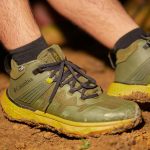Gore-Tex keeps you dry by using a microporous membrane that blocks liquid water but lets sweat vapor escape, so you stay comfortable. It’s highly waterproof thanks to its tightly bonded layers and DWR coating that repels water. However, wear, dirt, and improper care can reduce its effectiveness over time. With proper maintenance like gentle washing and reapplying DWR treatments, you’ll guarantee lasting protection. Keep exploring to understand how to maximize Gore-Tex’s performance in any conditions.
Table of Contents
Key Takeaways
- Gore-Tex’s microporous membrane blocks liquid water while allowing sweat vapor to escape, ensuring high waterproofness and breathability.
- The durable water repellent (DWR) coating causes water to bead off, preventing surface wetness and maintaining comfort.
- Waterproof performance depends on intact seams and undamaged fabric, as leaks usually stem from wear or damage, not membrane failure.
- Dirt, oils, and improper care can clog the membrane and degrade waterproofing, requiring regular cleaning and maintenance.
- Restoring DWR with spray-on or wash-in treatments and proper drying reactivates water repellency, sustaining Gore-Tex’s waterproof function.
Understanding the Technology Behind Gore-Tex
Although it might seem like just another fabric, Gore-Tex uses a unique membrane technology that keeps you dry while letting sweat escape.
You’ll find that this membrane contains microscopic pores, too small for water droplets to enter but large enough to let moisture vapor pass through. This means when you’re active, sweat doesn’t build up inside your clothing, preventing discomfort and dampness.
The membrane is also bonded between layers of fabric, making it durable and flexible. You’ll appreciate how this design balances waterproof protection with breathability, ensuring you stay comfortable in various weather conditions.
Understanding this technology helps you see why Gore-Tex stands out as a reliable choice for outdoor gear that performs well in wet environments without sacrificing comfort.
How Gore-Tex Fabric Repels Water
You’ll find Gore-Tex fabric uses a microporous membrane that blocks water while letting air pass through.
This structure gives it its unique water resistance without sacrificing breathability.
Let’s explore how this balance keeps you dry and comfortable.
Microporous Membrane Structure
The secret behind Gore-Tex’s waterproof ability lies in its microporous membrane structure. This membrane contains billions of tiny pores, each about 20,000 times smaller than a water droplet but large enough to let water vapor escape. This unique design keeps you dry by blocking liquid water outside while allowing sweat to evaporate.
| Feature | Pore Size (microns) | Function |
|---|---|---|
| Water Droplets | ~100 | Blocked by membrane pores |
| Water Vapor | ~0.0004 | Passes through pores |
| Membrane Thickness | 0.01 | Provides durability |
| Pore Count | Billions | Guarantees breathability |
| Material | ePTFE (expanded PTFE) | Maintains structure |
Understanding this structure helps you appreciate Gore-Tex’s remarkable waterproof and breathable performance.
Water Resistance Mechanism
Because Gore-Tex fabric uses a specialized membrane with microscopic pores, it actively repels water while letting moisture escape. You’ll find this mechanism relies on the unique size and structure of these pores that are smaller than water droplets but larger than water vapor molecules.
This way, liquid water can’t penetrate, but sweat vapor can pass through, keeping you dry inside. Here’s how it works in detail:
- Pore Size: The membrane’s tiny pores block liquid water but allow vapor through.
- Surface Tension: Water droplets can’t squeeze through the pores due to surface tension.
- Membrane Layering: Multiple layers enhance water resistance by providing extra barriers to penetration.
This clever design guarantees you stay protected from rain and snow without trapping moisture inside.
Breathability and Water Repellency
When you wear Gore-Tex, its breathability and water repellency work together to keep you comfortable in wet conditions.
The fabric’s microscopic pores stop liquid water from entering while allowing water vapor from sweat to escape. This means you stay dry both outside and inside your clothing.
Gore-Tex achieves water repellency through a durable water repellent (DWR) coating on the outer layer, which causes water to bead up and roll off instead of soaking in.
Meanwhile, the breathable membrane prevents water droplets from penetrating but lets moisture vapor pass through.
This balance prevents overheating and clamminess, so you don’t feel trapped inside your gear.
Factors Affecting Gore-Tex Waterproof Performance
Although Gore-Tex is renowned for its waterproof qualities, several factors can influence how well it performs in real-world conditions.
You might notice variations depending on how you use and maintain your gear. Here are three key factors to evaluate:
- Wear and Tear: Over time, the membrane can develop micro-tears or abrasions, reducing its waterproof ability.
- Dirt and Contaminants: Dirt, oils, and other substances can clog the outer durable water repellent (DWR) coating, causing water to soak rather than bead off.
- Improper Care: Washing with the wrong detergents or skipping reapplication of DWR treatments can degrade waterproof performance.
Comparing Gore-Tex With Other Waterproof Materials
When you compare Gore-Tex to other waterproof materials like nylon, you’ll notice differences in breathability and durability.
Understanding how each performs can help you choose the right gear for your needs.
Let’s explore how Gore-Tex stacks up in these key areas.
Gore-Tex vs. Nylon
Comparing Gore-Tex and nylon reveals key differences in waterproof performance and durability. While both materials are used in outdoor gear, Gore-Tex offers superior waterproofing thanks to its specialized membrane. Nylon, on the other hand, is typically treated with coatings that repel water but don’t provide the same level of protection over time.
Here’s what you need to know:
- Waterproofing: Gore-Tex uses a microporous membrane that blocks water but lets moisture escape, unlike nylon’s surface coatings which can wear off.
- Durability: Gore-Tex maintains waterproof integrity longer under harsh conditions, whereas nylon coatings may degrade with abrasion and exposure.
- Maintenance: Gore-Tex gear requires specific care to preserve its membrane, while nylon is easier to clean but less reliable when wet.
Choosing Gore-Tex means you get consistent, lasting waterproof performance over standard nylon.
Breathability Comparison
You’ll find that Gore-Tex stands out among waterproof materials for its breathability, allowing sweat and moisture to escape while keeping rain out.
Unlike traditional waterproof fabrics like PVC or rubber, which trap heat and moisture inside, Gore-Tex’s microporous membrane balances waterproofing with ventilation.
When compared to other breathable options like eVent or NeoShell, Gore-Tex offers reliable moisture management but may feel slightly less breathable under intense activity.
However, its proven ability to prevent water penetration without sacrificing comfort makes it a top choice.
If you prioritize staying dry without overheating, Gore-Tex delivers a solid middle ground.
Other materials trade off breathability for durability or cost, but Gore-Tex maintains an effective balance that suits most outdoor conditions.
Durability and Performance
Gore-Tex’s breathability is impressive, but how well does it hold up over time and tough conditions?
When you compare Gore-Tex to other waterproof materials, its durability and performance stand out. Here’s why you might choose Gore-Tex:
- Long-lasting waterproofing: Gore-Tex maintains its water resistance even after extended use and multiple washes, unlike some cheaper alternatives that degrade quickly.
- Abrasion resistance: The material resists tears and punctures better, so it’s ideal for rugged outdoor activities where gear takes a beating.
- Consistent breathability: Even as it ages, Gore-Tex continues to allow sweat to escape, keeping you comfortable without sacrificing waterproofness.
If you want gear that performs reliably in harsh conditions, Gore-Tex offers a balance of durability and functionality that many other materials can’t match.
Common Misconceptions About Gore-Tex Waterproofing
How waterproof is Gore-Tex really, and why do some people doubt its effectiveness?
You might hear that Gore-Tex isn’t truly waterproof or that it fails quickly in heavy rain. These misconceptions often stem from misunderstandings about how Gore-Tex works.
It’s designed to block liquid water while letting sweat vapor escape, but if your gear’s outer layer gets clogged with dirt or oils, it won’t perform as well.
Some think Gore-Tex lets water in because they’ve experienced leaks—often caused by worn-out seams or damage, not the fabric itself.
Also, Gore-Tex isn’t a permanent shield; it requires care to maintain its breathability and water resistance.
Knowing this helps you set realistic expectations and appreciate Gore-Tex’s actual capabilities without falling for myths.
Best Practices to Maintain Gore-Tex Waterproofing
Although Gore-Tex is designed to repel water, maintaining its waterproofing requires regular care and attention.
To keep your Gore-Tex gear performing at its best, you’ll want to follow a few simple steps.
- Clean Properly: Dirt and oils can clog the membrane. Use a gentle detergent and warm water to wash your Gore-Tex items, avoiding fabric softeners.
- Restore DWR Coating: The Durable Water Repellent (DWR) finish wears off over time. Apply a spray-on or wash-in DWR treatment after cleaning to renew water beading.
- Dry Correctly: Air-dry your gear or tumble dry on low heat if the care label allows. Heat helps reactivate the DWR coating.
Frequently Asked Questions
Can Gore-Tex Be Repaired if the Waterproof Layer Is Damaged?
Imagine raindrops sliding off your jacket’s surface—if the waterproof layer tears, you can’t just ignore it. You can repair Gore-Tex using specialized patches or professional services to restore its water resistance and keep you dry.
Is Gore-Tex Environmentally Friendly and Recyclable?
You’ll find Gore-Tex isn’t fully environmentally friendly since it uses fluorinated chemicals. However, the company’s working on recycling programs and eco-friendlier materials, so you can expect improvements in sustainability soon.
How Long Does Gore-Tex Typically Last With Regular Use?
You can expect Gore-Tex to last about 5 to 10 years with regular use, depending on care and activity. Proper cleaning and storage help maintain its durability and waterproof performance over time.
Does Gore-Tex Provide Insulation or Only Waterproofing?
Gore-Tex doesn’t provide insulation itself; it mainly offers waterproofing and breathability. You’ll want to layer insulating materials underneath to stay warm, especially in cold conditions, while Gore-Tex keeps you dry and comfortable.
Can Gore-Tex Fabrics Be Dyed or Customized After Manufacturing?
You might think you can easily dye Gore-Tex like regular fabric, but you can’t. Its waterproof membrane resists dyes, so customizing it after manufacturing is tricky—you’ll need specialized processes or choose pre-dyed options instead.
- What Is Pima Cotton Percale? A Premium Bedding Option - July 14, 2025
- What Does “Percale Sheet” Mean? A Simple Definition - July 14, 2025
- Do Cotton Percale Sheets Contain Polyester? How to Read the Label - July 14, 2025







